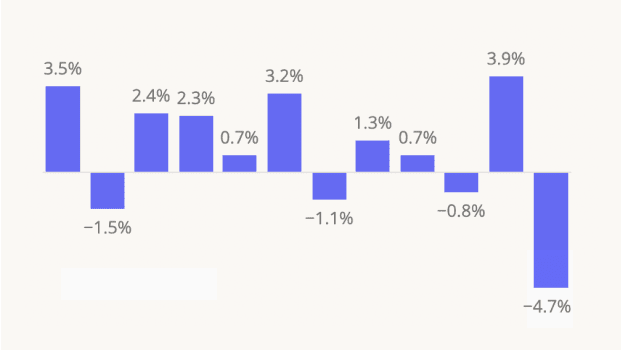
As new retail construction slows, the trend of repurposing underperforming malls is accelerating, offering exciting opportunities to transform these properties into vibrant mixed-use developments. By blending retail, lifestyle, entertainment, and essential services, these redevelopments can better serve the evolving needs of today’s consumers. Class B malls offer significant potential for investors and retailers to unlock value while meeting the needs of local communities.
Characteristics of Class-B Malls
According to Green Street, there are 250 Class-B malls in the U.S., making up 28% of all U.S. malls. These properties are typically located in suburban or secondary markets and often feature a mid-tier tenant mix of national and regional retailers within a traditional enclosed mall format. According to Green Street data, A-rated malls boast an impressive 95% occupancy rate, while B malls sit at 89%. Meanwhile, occupancy drops significantly to 72% for C-rated malls and below.
B Malls face a number of challenges in addition to their higher vacancy rates, including lower sales per square foot, less desirable locations, outdated designs, and competition from newer lifestyle centers that offer a more dynamic mix of retail, dining, and entertainment.
The Future of Class-B Malls
Class-B malls, despite their challenges, offer a compelling opportunity for adaptive reuse. Often priced below their original value, these properties are ideal for redevelopment into community-centric hubs, featuring a mix of residential, retail, and public spaces. Reimagining these spaces not only allows investors and developers to achieve significant returns, but also fosters positive economic growth in local communities. For retailers, these revitalized spaces offer the chance to thrive in environments with increasing foot traffic and elevated customer engagement.
Promising redevelopment ideas include:
- Densification and Mixed-Use Developments: Incorporating residential components – like multifamily housing, age-restricted communities, or mixed-income units – can breathe new life into surrounding neighborhoods and create walkable communities while addressing critical housing needs. Adding office spaces, co-working hubs, and hospitality services further enhances the property’s versatility, catering to a wide range of needs.
- Experiential Retail Hubs: Transforming B malls into experiential spaces can attract younger demographics and re-engage shoppers. This could include entertainment venues like escape rooms, virtual reality experiences, live music, or food and beverage experiences such as craft breweries or celebrity chef-driven food halls.
- Healthcare & Community Spaces: Some B malls are being repurposed into vital community hubs, incorporating medical offices, educational institutions, and municipal services to meet the daily needs of consumers.
- Last Mile Distribution and Data Centers: The rise of e-commerce and demand for data centers has led to the conversion of some B malls into last-mile distribution centers or tech hubs, especially in suburban areas with large footprints and access to transportation networks.
- Anchor Repurposing: As anchor tenants such as Sears and JCPenney exit, repurposing these stores into larger-format retailers, fitness centers, or indoor sports complexes offers a chance to create new, engaging destinations for local communities.
- Partial Redevelopment: Many B malls are hindered by outdated, closed-off designs. By opening spaces, adding green areas, outdoor-facing stores, and lifestyle features, developers can create more inviting environments that appeal to today’s consumers.
Revitalizing B Malls – The Case of Hawthorn Mall
Hawthorn Mall, a premier two-story super-regional shopping center in Vernon Hills, Illinois, is one B Mall currently undergoing a significant transformation – and early data suggests that the revitalization efforts are already bearing fruit.
Owned by Centennial Real Estate, Hawthorn is strategically positioned at the intersection of Lake County’s key thoroughfares, offering exceptional convenience and accessibility. The center is anchored by major brands like AMC, Dave & Buster’s, JCPenney, and Macy’s, with a diverse mix of more than 60 retailers and restaurants, including Anthropologie, FP Movement, H&M, Lovesac, PGA Tour Superstore, Perry’s Steakhouse & Grille, and Pure Barre. Now, in the midst of redevelopment, Hawthorn is evolving into a vibrant mixed-use community, integrating luxury residential, expanded retail and dining, and pedestrian-friendly spaces.
Although the Hawthorn Mall redevelopment is still under way, visit quality to the mall has already improved – with the median visit duration rising from 54 minutes between April 2022 and March 2023 to 61 minutes between April 2024 and March 2025. The median household income in Hawthorn’s captured market has increased as well, perhaps thanks to the addition of a luxury apartment complex on the mall’s property. Lastly, the share of evenings visits also grew, suggesting that Hawthorn's revamped dining and entertainment are making it an increasingly popular evening destination for locals.
Looking Ahead
Class-B malls represent a unique opportunity to meet both market demands and community needs through thoughtful redevelopment. While challenges such as securing financing, navigating zoning and regulatory hurdles, and managing costs exist, the potential rewards are significant. Successful redevelopment requires targeted tenant curation, strategic location, and a bold, forward-thinking vision. With expansive footprints, prime access, and adaptability, Class-B malls are perfectly positioned to evolve into dynamic, mixed-use centers – redefining retail experiences and meeting the needs of modern consumers and communities.




.svg)





.png)
.png)

.png)
.png)



